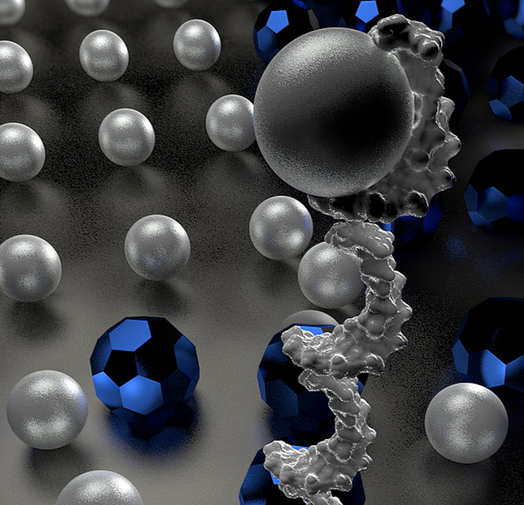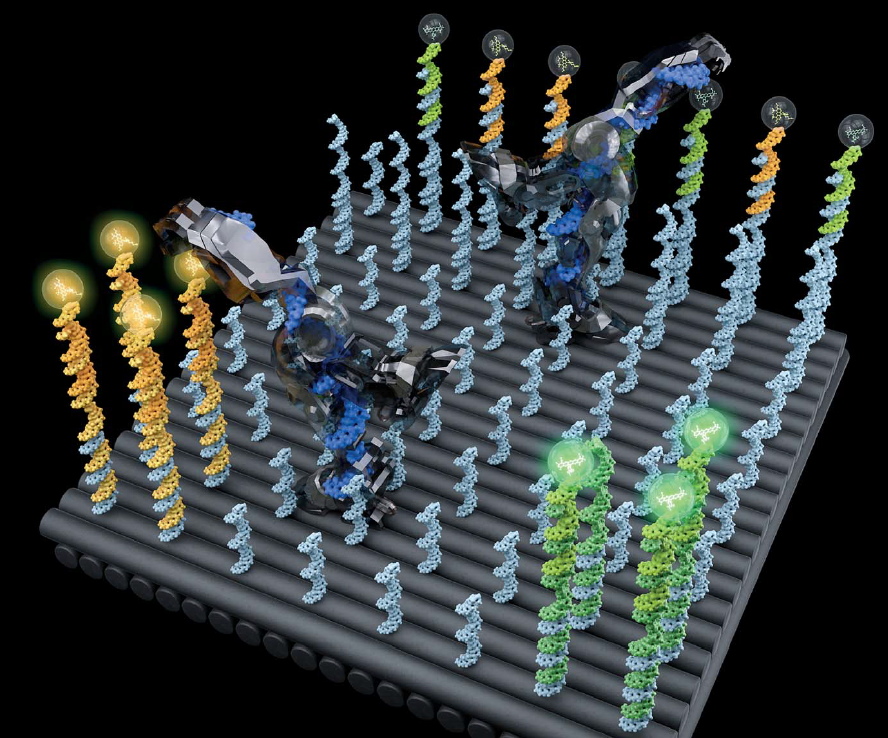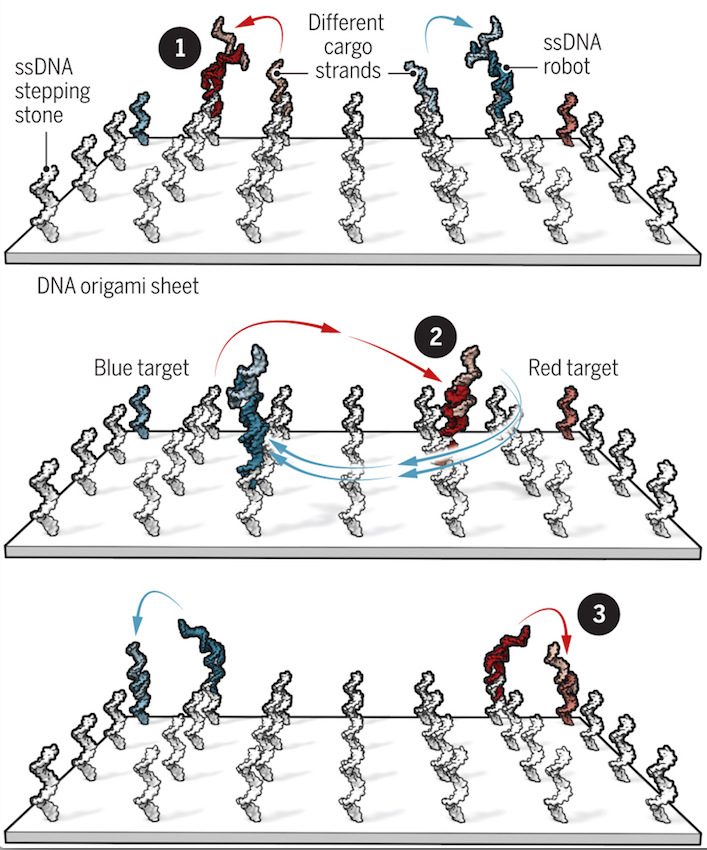Walking DNA nanorobot could deliver a drug to a precise location in your body
September 15, 2017

DNA nanorobot cargo carrier (artist’s impression) (credit: Ella Maru Studio)
Caltech scientists have developed a “cargo sorting” DNA nanorobot programmed to autonomously “walk” around a surface, pick up certain molecules, and drop them off in designated locations.
The research is described in a paper in the Friday, September 15, 2017 issue of Science.
The major advance in this study is “their methodology for designing simple DNA devices that work in parallel to solve nontrivial tasks,” notes Duke University computer scientist John H. Reif in an article in the same issue of Science.
Such tasks could include synthesizing a drug in a molecular factory or delivering a drug only when a specific signal is present in bloodstreams, say the researchers. “So far, the development of DNA robots has been limited to simple functions,” the researchers note.
Walking nanobots that work in parallel

Conceptual illustration of two DNA nanorobots collectively performing a cargo-sorting task on a DNA origami surface: transporting fluorescent molecules with different colors from initially random locations to ordered destinations. (credit: Demin Liu)
The DNA nanorobot, intended as a proof of concept, has a “leg” with two “feet” for walking, and an “arm” and “hand” for picking up cargo. It also has a segment that can recognize a specific drop-off point and signal to the hand to release its cargo. Each of these building blocks are made of just a few nucleotides (molecules that form DNA) within a single strand of DNA.*
As the robot encounters cargo molecules tethered to pegs, it grabs them with its “hand” components and carries them around (with a 6-nm step size) until it detects the signal of the drop-off point.

Multiple DNA nanorobots independently execute three operations in parallel: [1] cargo pickup, [2] random movement to adjacent stepping stones, and [3] cargo drop-off at ordered locations. (credit: C. Bickel/Science)
“The same system design can be generalized to work with dozens of types of cargos at any arbitrary initial location on the surface,” says lead author Anupama Thubagere. “One could also have multiple robots performing diverse sorting tasks in parallel,” [programmed] like macroscopic robots.”
Future applications
“We don’t develop DNA robots for any specific applications. Our lab focuses on discovering the engineering principles that enable the development of general-purpose DNA robots,” explains Lulu Qian, assistant professor of bioengineering.
“However, it is my hope that other researchers could use these principles for exciting applications, such as synthesizing a therapeutic chemical from its constituent parts in an artificial molecular factory, or sorting molecular components in trash for recycling. Just like electromechanical robots are sent off to faraway places, like Mars, we would like to send molecular robots to minuscule places where humans can’t go, such as the bloodstream.”
Funding was provided by Caltech Summer Undergraduate Research Fellowships, the National Science Foundation, and the Burroughs Wellcome Fund.
* The key to designing DNA machines is the fact that DNA has unique chemical and physical properties that are known and programmable. A single strand of DNA is made up of four different molecules called nucleotides—abbreviated A, G, C, and T—and arranged in a string called a sequence. These nucleotides bond in specific pairs: A with T, and G with C. When a single strand encounters a “reverse complementary strand” — for example, CGATT meets AATCG —the two strands zip together in the classic double-helix shape.
** Using these chemical and physical principles, researchers can also design “playgrounds,” such as molecular pegboards, to test them on, according to the researchers. In the current work, the DNA robot moves around on a 58-nanometer-by-58-nanometer pegboard on which the pegs are made of single strands of DNA complementary to the robot’s leg and foot. The robot binds to a peg with its leg and one of its feet — the other foot floats freely. When random molecular fluctuations cause this free foot to encounter a nearby peg, it pulls the robot to the new peg and its other foot is freed. This process continues with the robot moving in a random direction at each step.
Abstract of A cargo-sorting DNA robot
Two critical challenges in the design and synthesis of molecular robots are modularity and
algorithm simplicity.We demonstrate three modular building blocks for a DNA robot that
performs cargo sorting at themolecular level. A simple algorithm encoding recognition between
cargos and their destinations allows for a simple robot design: a single-stranded DNA with
one leg and two foot domains for walking, and one arm and one hand domain for picking up and
dropping off cargos.The robot explores a two-dimensional testing ground on the surface of
DNA origami, picks up multiple cargos of two types that are initially at unordered locations, and
delivers them to specified destinations until all molecules are sorted into two distinct piles.
The robot is designed to perform a random walk without any energy supply. Exploiting this
feature, a single robot can repeatedly sort multiple cargos. Localization on DNA origami allows
for distinct cargo-sorting tasks to take place simultaneously in one test tube or for multiple
robots to collectively perform the same task.